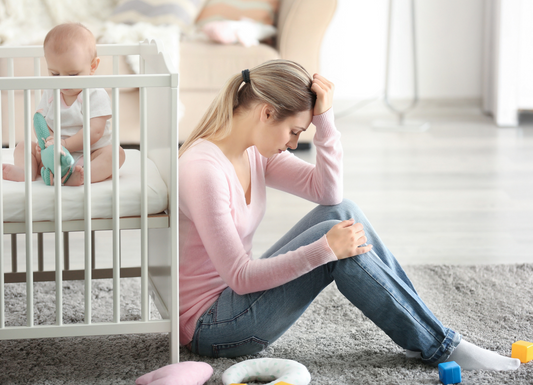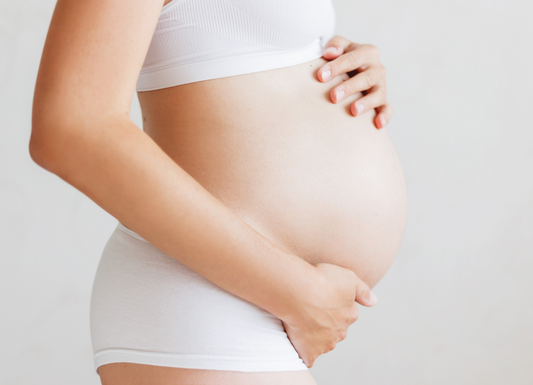Being pregnant puts a lot of pressure on your pelvic floor. Uh, yeah, thanks for that Captain Obvious.
The good news is, a woman’s body is perfectly designed to achieve the truly amazing feat of carrying and birthing a baby. The double good news is that there are a bunch of things you can do to prepare your core, pelvis and pelvic floor for childbirth. Things that are going to support you to have a better birth experience and a quicker recovery once your baby is born.
Oh, and let's not forget about taking care of your pelvic health after pregnancy, too. Whether your baby is delivered by c-section or vaginally, your pelvis has dealt with some serious stress and your body needs a little extra love to recover and repair.
Read on for five pro tips for a healthy pelvic floor during pregnancy and beyond.
Tip one - practice good toilet habits
We’re starting with poos and wees because it’s what your life is going to be all about as a new mama (so you may as well get used to it).
With all those hormones flying around your body, and the pressure of your uterus and baby on your bladder and bowel is it any wonder that both constipation and incontinence are very real and common side-effects of pregnancy?
Good toilet habits can help you manage constipation and are also super important for your pelvic floor. And by good toilet habits, we don’t mean washing your hands after (although you should still totally do that).
We mean only go to the toilet when you need to! Going "just in case" (even during the night) can train your bladder to hold less urine than it should. When you do go make sure you empty your bladder and bowel completely by waiting a few seconds even after you think you’re done.
Good toilet habits also means working on your posture, position and breathing so you’re avoiding pushing and straining as much as possible. Because straining can lead to haemorrhoids, nerve damage and even prolapse (yikes).
So what’s a good position? The Continence Foundation of Australia recommends getting into a squat position where your knees are higher than your hips (a stool can help), leaning forward with your elbows on your knees, straightening your spine, relaxing and letting your tummy settle onto your thighs.
Tip two - get a pelvic floor check-up
We know you’re busy with hospital appointments, midwife visits, GP checkups and all the rest. But we want you to add a pelvic floor specialist into the mix to help you avoid prolapse, incontinence and all the other not so nice stuff that can come with pregnancy and childbirth.
All women should be getting regular pelvic health check-ups but it’s especially important during this time in your life. Even if you don’t have any pain and symptoms a pelvic health specialist (like a women’s health physio) can make sure things are working as they should and nip any emerging issues in the vulva.
A good pelvic health specialist can prepare you for labour by teaching you what it feels like to push effectively. They can also help you gain awareness of your pelvic floor and teach you how to connect with and activate it correctly. This is super important. If you aren’t doing the right exercises for your specific needs, you might actually make things worse. And bonus! Being aware of this area and what it feels like to connect to it before labour makes it a little easier to figure out how to connect there again after labour.
They can also give you the right pelvic floor exercises for your body.
Thanks to the popular belief that a tighter vagina is a better vagina (insert eye roll here) loads of people think that going hard at it with the kegels is the key to improving their pelvic health. But kegels aren’t the easy cure-all for pelvic health issues that they’re made out to be.
And your pelvic floor doesn’t work in isolation. It might be that your hip muscles are not working correctly or you’re not breathing effectively and overusing your obliques. Seriously, it’s not always straightforward, and it’s not something you can self diagnose and treat.
Tip three - practice your birthing positions
Something that loads of women don’t think about when they’re prepping for childbirth is learning different labour positions that are going to help them to push effectively. And you should care about pushing effectively because it can help avoid prolapse, perineal trauma and other pelvic floor issues.
We see a lot of birthing scenes on the tv and in movies where the woman is flat on her back, knees up in the air, but for most women, this isn’t a great position for pushing out a baby.
Effective pushing involves a soft and relaxed pelvic floor to allow for easy passage of the baby combined with a strong abdominal contraction to increase the pressure in the abdomen above the baby and help push baby down and out.
The most effective pushing position for each woman and birth will be different. Some positions that you thought might be good for you may not feel comfortable when the time comes, or you might be restricted if you’ve had an epidural so practicing a a few different positions ahead of time means you’ll have more options when you’re in the moment.
There are so many great resources and child birthing classes out there to help you practice good birthing positions and prepare for labour more generally. There really is something for everyone, so keep looking if the first one you find doesn’t feel right for you. Check out Hypnobirthing, Calmbirth, Active Birth, Spinning Babies, Birth Skills and Ina May’s Guide to Childbirth.
Tip four - get your perineum ready
Massage, warm compresses and different perineal management techniques are widely used by midwives and birth attendants to promote stretching during labour and help women who give birth vaginally avoid tearing, episiotomy and instrumental delivery (forceps or vacuum).
Your pelvic health specialist (see tip two) can show you and your partner how to massage your perineum in preparation for childbirth. And you can also help your perineum stretch better during labour by applying a heat pack. Who knew (*whispers* us!)
Tip five - prepare a mama first aid kit
Every new mama's experience is different, but right after your baby is born you’re likely going to be a cute gooey puddle of loved up mess and hormones.
Just a side note here: if you feel like you’re not bonding with your baby or you’re experiencing high levels of distress, unhappiness, exhaustion or worry please seek help and support. PANDA is a great place to start. They also have a confidential helpline 1300 726 306.
While you’re busy looking after the tiny human you have suddenly become responsible for it can be hard to remember to look after yourself.
Having a few first aid kit essentials packed into your hospital bag and ready for your return home can help you make your own pelvic health a priority during the fourth trimester.
We have a bunch of fantastic products available in The Pelvic Hub shop to get your kit started, including perineal cooling/warming pads, ab wraps, exercise programs, pelvic heat packs, breast and nipple soothers, lubricants and vaginal moisturisers, pelvic cushions, and more (phew!). If you want to read more about how our products can help check out our pre- and postnatal information.
Also, don’t forget to ask the mums in your social circle about what they liked and what worked well for them. Other mums are a great source of information, recommendations, real-life advice, funny anecdotes and support.
More information and resources
When you’re heading into motherhood there’s so much you don’t know, you don’t know. And taking care of your pelvic health is just part of the picture. If you’re looking for more information to support you during this time we recommend:



